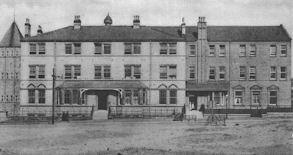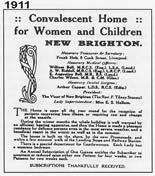The ‘Convalescent Home For Women and Children’ in Rowson Street, New Brighton, was founded in 1847 and was originally known as the ‘Sea-side Institution For Women’. The institution was intended for the reception of women patients…’recovering from illness or requiring rest and change at the seaside’ ... and was opened all year round for the benefit of patients, thus making it a “pleasant residence for delicate persons even in the most severe weather’ writes Philip Sulley in 1889. He maintained that the institution was established…”to afford a comfortable home for poor women when recovering from illness at a very moderate charge”…, with the balance being met by voluntary subscription. The Home maintained a kind of two-tier system, containing 62 beds for women and children and an additional 12…’special departments for Gentlewomen…each lady having a separate bedroom’. Managed by a superintendent/matron who supervised a resident staff of nurses and domestic servants, its operation was based upon a charitable system whereby an annual subscription entitled the subscriber to nominate either one patient for four weeks or two patients for two weeks each; while, naturally, other donations were sought and ‘thankfully received’ by the Institution’s administrators.
Morris’s 1880 Cheshire Directory actually quotes the weekly terms for patients, which were: 10s.6d a week, or 6s.6d a week with subscriber’s nominations, for the 62 ordinary beds, and 21s a week, or 15s a week with subscriber’s nominations, for gentlewomen’s departments. And when nineteenth century census returns are consulted it soon becomes apparent that both staff and patients came from rather mixed social backgrounds. It is most interesting to note for instance – in the context of listed ages, duties and occupations – these women’s respective positions in the Convalescent Home’s structure itself, and in Victorian society generally outside of the Home, where, once again, the hierarchy of servants is exemplified, and where it is quite possible to identify the ‘gentlewomen’ among the patient listings. Similarly, it is also interesting to find that the vast majority of staff and patients, regardless of position, were unmarried. The 1891 Census Report reveals that 31 of the 33 patients in the Home at the time were either widowed (five examples) or unmarried, and all eleven staff were single women; while patients occupations ranged from ‘professor of music’ and ‘private income’ to housekeepers, dressmakers and general servants, and staff ranged from nurses and cooks to ward maids, scullery-maids and waitresses.
The Sea-side Institution’s foundation was in line with a substantial mid-nineteenth century increase of charitable organisation's being established throughout the rest of the country. Of course, this charitable activity could be a means of attaining social mobility and, as Margaret Simey had argued…’”through the subscription list of a charity one could display one’s wealth to public view, co-operate openly with the aristocracy and thus buy a place in public life’. Whether such factors inspired the establishment of New Brighton’s most noted charitable organisation is a point that is open to question, but it is true that the Institute’s early patronesses did include certain members of the aristocracy, whilst the various administrative committees read like a veritable who’s who of respectable middle-class society in the resort.
The Institution’s Committee member listing from the year 1861 provides a good illustrative example of the type of person involved in the management structure:
Sea-Side Institution For Women, New Brighton |
|
Patronesses |
|
| The Duchess of Marlborough | The Marchioness of Westminster |
| The Countess of Manves | The Countess Howe |
| Viscountess Fielding | The Lady Leigh |
| The Baroness De Clifford | The Hon. Lady Cust |
Mrs Newdegate |
|
Committee |
|
The Rev. F. Haggit |
|
| The Rev. R.D Powell | Thomas Addison |
| William R Coulborn. ESQ | Charles Groves. ESQ |
| John North. ESQ | Alfred Parr. ESQ. M.D |
| William Rathbone. JUN. ESQ | John Trull. ESQ. M.D |
Peter Wright. ESQ |
|
Committee Of Management |
|
Mrs Lady Mary Fielding |
|
| Mrs Bouch | Mrs M. Bulley |
| Mrs Powell | Mrs Coulborn |
| Mrs Hamilton | Mrs North |
| Mrs C. Pickering | Mrs Wright |
Hon Sec & Treasurer |
|
Peter Wright. ESQ |
|
Superintendent |
|
Miss Dixon |
|
Chaplain |
|
Rev R.D Fowell |
|
Medical Visitors |
|
Dr A Parr - New Brighton |
|
Dr J Trull - New Brighton |
|
A noticeable feature of the list was the apparent approval of husbands and wives to sit on respective committees, and the presence of prominent local couples like the Fowells, Coulborns, Groves, Norths and Wrights meant that much of the Institution’s administration was kept, quite literally, in the family. This point was also evident in other cases where committee places were passed on from generation to generation. Mrs Mary Bulley, for instance, would hand her position on to daughter-in-law Louisa, the wife of her eldest son Thomas Raffles Bulley, in the final quarter of the century. Whilst similarly, John North’s wife Frances would be superseded on the Management Committee by her daughter-in-law Margaret, wife of Frederick North (who donated to the building of St. James Church).
The Secretary and Treasurer of the Sea-side Institution for Women at this time, Peter Wright, an attorney by profession, and Clerk of the Peace for the Borough of Liverpool from 1844-1877, was another wealthy member of local middle-class society whose family would play a significant in the Institutions affairs and, indeed, in the case of one of his sons, in the history of New Brighton resort generally. Wright had crossed the river, with his wife Anne and their six children, in the late 1840s, departing their former home in Edge Lane, Liverpool to take up residence in a house called ‘Sea View’, in Marsden Lane (renamed Seaview Road). The family then went on to live in a selection of some of the finest houses in Liscard, Wallasey and New Brighton during the mid-Victorian period. Most notably ‘Clifton Hall’, Withens Lane, Liscard, ‘Heathbank’, in Breck Road, Wallasey and ‘Hollins Hey', in Victoria Road, New Brighton where Peter appears to have spent his final years of his life in the 1870s.
As indicated in the last paragraph, Peter Wright’s third son, Albert Wright (1844-1911) would also make his mark in his own right. Albert followed his father’s footsteps professionally as a practising attorney and, ultimately, as a senior partner in the family law firm of Wright, Beckett and Wright. Co. Ltd. of Water Street, Liverpool. But it was in his activities as a distinguished political representative for New Brighton and Wallasey in the late nineteenth and early twentieth century that he gained most credit. He served as a representative of both New Brighton and Wallasey upon the old Wallasey Local Board, being elected as member of the authority at the remarkably young age of 22, and ascending to Chairman of the Board, at the equally remarkable age of 30, in 1874, a position he held for four years.
In the 1890s and early 1900s Wright represented both Wallasey Ward on Wallasey Urban District Council (formed in 1894) and the New Brighton and Wallasey Division on Cheshire County Council, upon he gained the distinction of being elected an Alderman. And his great interest in the municipal life of the District ensured that he was a holder of many other important local government posts within this period. For example, he was prominently connected with educational matters as Clerk of the Governors of Wallasey Grammar School and was a member, and past Chairman, of Sub-Committee for Higher Education. In addition, he was closely involved in the establishment of Wallasey Central Library, in Earlston Road in his capacity as Chairman of the Libraries Committee.
Alderman Wright finally left the area in 1906, moving to Weston Rhyn, near Oswestry, on the Welsh Borders, where he died at his home in 1911 at the age of 67.
The position of Secretary and Treasurer of the Convalescent Home was held by some other prominent local men in the late nineteenth and early twentieth century who continued the work that Peter Wright had honourably pursued during the 1860s and 1870s, including: produce broker Edward H. Harrison, a relative of the famous shipping family, and an early occupant of ‘Breckhey’, in Mount Pleasant Road, Upper Brighton, and chartered accountant Peter Holt, the brother of Mary, who was the Superintendent of St. James Sunday School for more than 40 years, and youngest son of George and Jane Holt of ‘Fernhill’, in Rowson Street, who was born in New Brighton in 1863, and who occupied the Secretary’s office in the period leading up to the First World War.
Some other interesting members of the Sea-Side Institution’s Committee were wealthy merchant William Rathbone Jnr, whose charitable activities and creditable activities in the field of social reform have been well documented, and share broker Thomas Addison who doubled his efforts at the Rowson Street institution with an undertaking as Secretary of the New Brighton Assembly Rooms. This attractive meeting-place was once located next to the Victoria Hotel in Albion Street, was built in 1855 to facilitate the social events, and functions of a fashionable social scene in the blossoming resort. It is with no doubt that society fund-raising balls for the Convalescent Home were held.
Male patients were admitted to the Home for the first time during the 1914-1918 war when it was used as a hospital for wounded soldiers. But after the war ended it appears the Home’s fortunes took a downward turn and about 1920-1923 – the Convalescent Home was forced into closure. The building was then purchased by a religious order called the ‘Sisters of the Holy Family’ who reopened it as a Roman Catholic High School called the ‘Maris Stella’ in 1924. This school, in turn, existed for almost another 50 years before finally closing its doors to pupils in 1972. Sadly, the old Rowson Street building, for so long a fixture on the New Brighton scene, lay empty for a time before becoming the subject of a demolition order to make way for proposed new housing. Today two impressive blocks of flats, named Nelson Court and Rodney Court, stand upon the site.
Reference : The Inviting Shore by Anthony M. Miller and available at Amazon
Featured sites
- Non Gamstop Casinos
- Casino Not On Gamstop
- UK Casinos Not On Gamstop
- Non Gamstop Casinos UK
- Sites Not On Gamstop
- Sites Not On Gamstop
- Casinos Not On Gamstop
- Casinos Not On Gamstop
- Casinos Not On Gamstop
- Non Gamstop Casino UK
- Casinos Not On Gamstop
- Non Gamstop Casino
- UK Online Casinos Not On Gamstop
- UK Online Casinos Not On Gamstop
- Non Gamstop Casinos
- Casino Sites Not On Gamstop
- Casinos Not On Gamstop
- Casinos Not On Gamstop
- Best Betting Sites
- Casinos Not On Gamstop
- Gambling Sites Not On Gamstop
- Betting Sites That Are Not On Gamstop
- Non Gamstop Casinos UK
- UK Online Casinos Not On Gamstop




